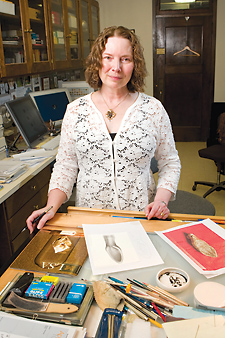Bonnie Miljour could be called a true artist, as she loves art for its own sake. “I will do any creative project that presents itself, given the opportunity,” she says.
Originally from Uusi Suomi in Michigan’s Upper Peninsula, Miljour attended Eastern Michigan University to study art. Midway through her undergraduate work she encountered watercolor.

Photo by Scott Soderberg, U-M Photo Services.
“The very first time that I handled the medium I knew I loved it,” she says. Miljour ultimately completed a Master of Fine Arts in watercolor.
But it was her passion for close observation and accurate depiction of natural objects that resulted in a position as senior scientific illustrator for the Museum of Paleontology. Her museum work calls on her to illustrate and reconstruct complex fossil finds for U-M curators and research scientists.
“I absolutely love my job,” Miljour says. “I would be hard pressed to say what part I like best, but probably it is the intricate halftone drawings and the re-assembly of ancient animals that fascinates and rewards me most. These things are tricky and demand all of my skills. I like to know that my work has a value that will outlive me.”
With artists, one thing always seems to lead to another. Miljour eventually found herself producing a series of fine illustrations for a children’s book about bats called “Pippa’s First Summer.” She has drawn bat fossils and reconstructions for the museum, including a cover for “The Journal of Vertebrate Paleontology.” Her research of bats soon became common knowledge.
One day some folks from out of town brought an infant bat to the museum. They were directed to Miljour, who recognized the necessity of acting quickly. She took the baby bat home and phoned Bat Conservation International for help.
“She was so tiny,” Miljour recalls. “I wasn’t even sure it was a bat. Without fur, its pink body resembled that of a baby bird. But it had dark brown ears, muzzle, wings and tail.”
They advised her to keep and raise it if possible, sensing that rehabilitation was not feasible. Bibe (bee-bee) the brown bat lived with Miljour for the next 17 years and provided a model for her drawings.
Miljour says raising Bibe was a joy as she showed individuality and was affectionate. “She liked to be held against my ear, and would purr like a cat. We had a few games — she would run up the inside of my shirt and come out the sleeve,” she says.
Miljour was careful when showing Bibe to others because often people were afraid. But generally they warmed to her quickly. Miljour always cautioned them about handling wild bats because they can carry diseases.
Bibe often vacationed with Miljour, carried in a screen-roofed Styrofoam cooler, her home away from home.
In addition to the scientific illustrations she produces at work and her watercolors, Miljour also works with collage, textiles and jewelry. “I like work that is unique,” she says. “I am especially drawn to an expressive use of color.
“At times, when I have gone through a difficult illness or hardships, I have especially depended on my artwork to see me through. Creativity has always been of central importance to me.”
When not at the museum, Miljour likes to be with her husband of 37 years, and their Papillion pup, Paige. “I do an awful lot of reading,” she says. Miljour has created seashell, rock and mineral collections, and enjoys creating family photo albums. Travel also has enriched her life. “We’ve camped in the Olympic Mountains and the Hoh Rain Forest, and spent some time exploring Costa Rica,” she says. Miljour says three weeks she spent in Italy studying Renaissance and Baroque art were life-changing.
The weekly Spotlight features staff members at the university. To nominate a candidate, please contact the Record staff at [email protected].

